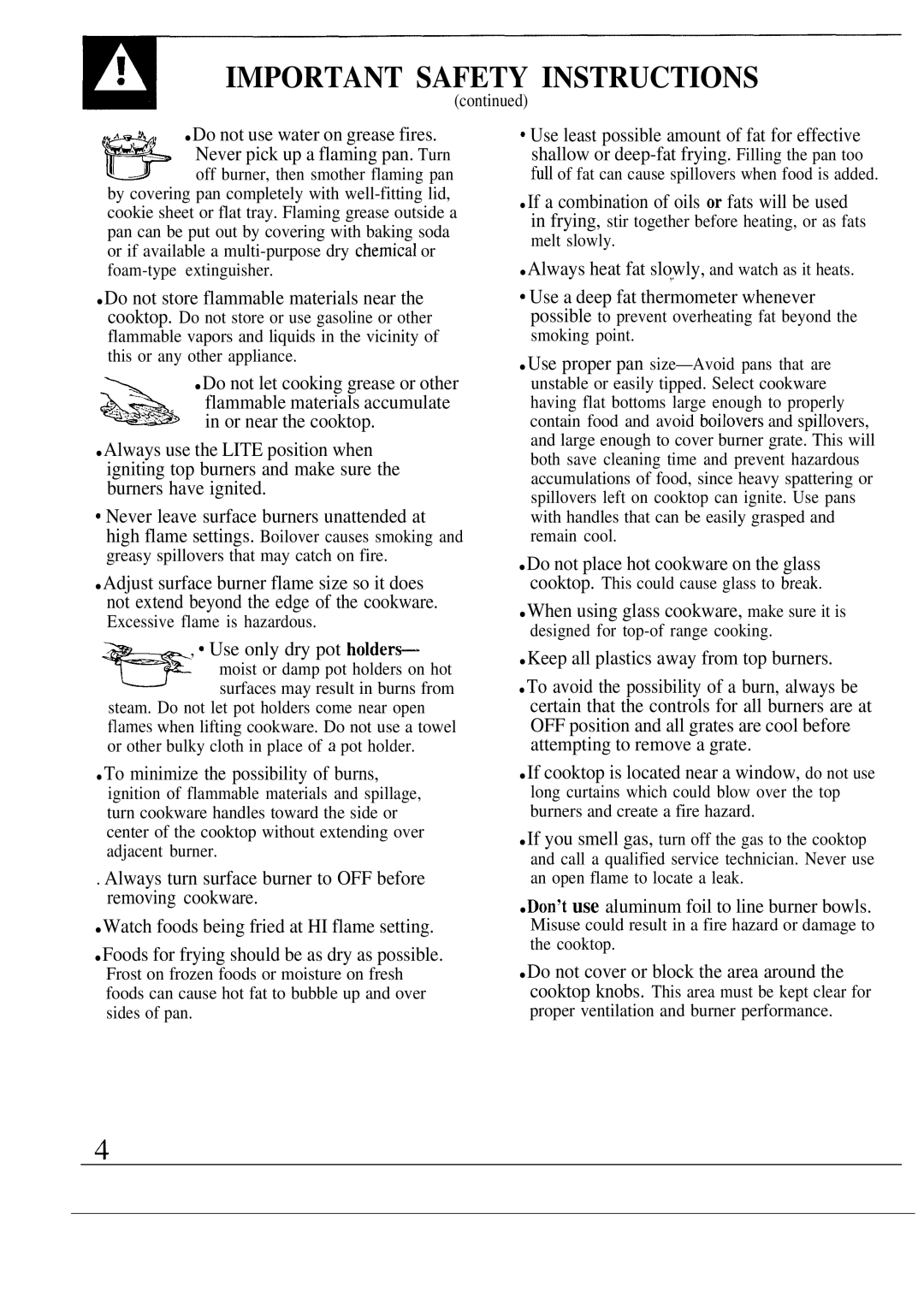
| J |
|
|
| |
| I | IMPORTANT SAFETY INSTRUCTIONS | |||
| e | ||||
|
|
| (continued) | ||
,A | ● Do not use water on grease fires. |
| Q Use least possible amount of fat for effective | ||
4 | ;: j’ | Never pick up a flaming pan. Turn |
| shallow or | |
& off burner, then smother flaming pan |
| fufl of fat can cause spillovers when food is added. | |||
by covering pan completely with |
| ● If a combination of oils or fats will be used | |||
cookie sheet or flat tray. Flaming grease outside a | |||||
in frying, stir together before heating, or as fats | |||||
pan can be put out by covering with baking soda |
| ||||
| melt slowly. | ||||
or if available a |
| ||||
| ● Always heat fat slowly, and watch as it heats. | ||||
| extinguisher. |
| |||
|
|
|
| ,. | |
●Do not store flammable materials near the cooktop. Do not store or use gasoline or other
flammable vapors and liquids in the vicinity of this or any other appliance.
● Do not let cooking grease or other
Q Use a deep fat thermometer whenever possible to prevent overheating fat beyond the smoking point.
● Use proper pan |
unstable or easily tipped. Select cookware |
“~ -:+ .>, .:
flammable materials accumulate
having flat bottoms large enough to properly |
& in or near the cooktop.
● Always use the LITE position when igniting top burners and make sure the burners have ignited.
* Never leave surface burners unattended at high flame settings. Boilover causes smoking and greasy spillovers that may catch on fire.
●Adjust surface burner flame size so it does not extend beyond the edge of the cookware.
Excessive flame is hazardous.
, c Use only dry pot holders——
moist or damp pot holders on hot
Bsurfaces may result in burns from
steam. Do not let pot holders come near open flames when lifting cookware. Do not use a towel or other bulky cloth in place of a pot holder.
●To minimize the possibility of burns,
ignition of flammable materials and spillage, turn cookware handles toward the side or center of the cooktop without extending over adjacent burner.
. Always turn surface burner to OFF before removing cookware.
●Watch foods being fried at HI flame setting.
●Foods for frying should be as dry as possible.
Frost on frozen foods or moisture on fresh foods can cause hot fat to bubble up and over sides of pan.
contain food and avoid boiIovers and spilIovers, |
and large enough to cover burner grate. This will |
both save cleaning time and prevent hazardous |
accumulations of food, since heavy spattering or |
spillovers left on cooktop can ignite. Use pans |
with handles that can be easily grasped and |
remain cool. |
● Do not place hot cookware on the glass |
cooktop. This could cause glass to break. |
● When using glass cookware, make sure it is |
designed for |
● Keep all plastics away from top burners. |
● To avoid the possibility of a burn, always be |
certain that the controls for all burners are at OFF position and all grates are cool before attempting to remove a grate.
●If cooktop is located near a window, do not use
long curtains which could blow over the top burners and create a fire hazard.
●If you smell gas, turn off the gas to the cooktop and call a qualified service technician. Never use an open flame to locate a leak.
●Don’t use aluminum foil to line burner bowls.
Misuse could result in a fire hazard or damage to the cooktop.
●Do not cover or block the area around the cooktop knobs. This area must be kept clear for proper ventilation and burner performance.
